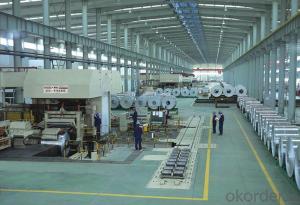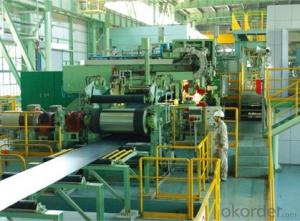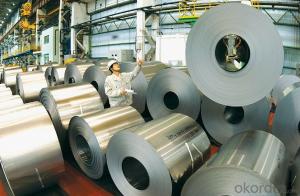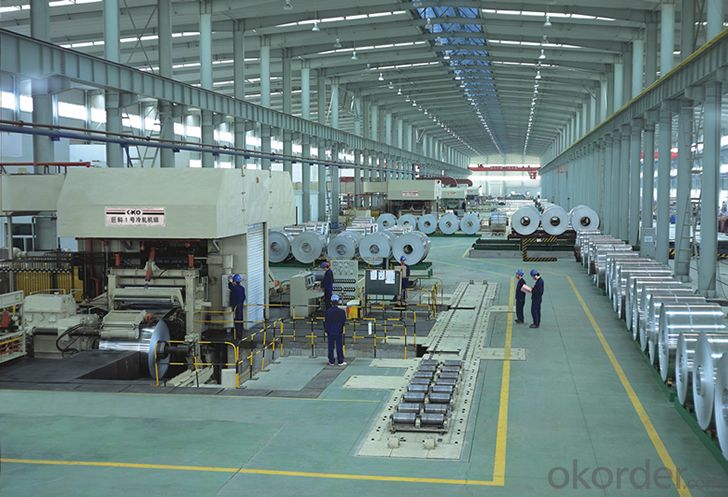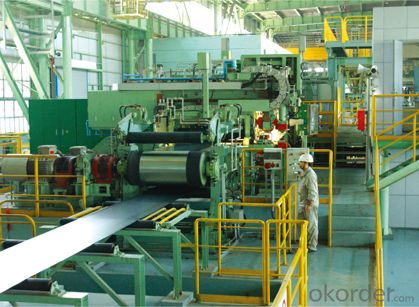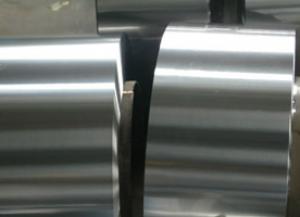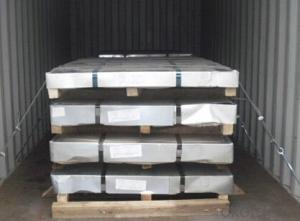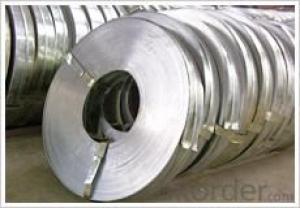Cold rolled steel coil and sheet and sheet
- Loading Port:
- Tianjin
- Payment Terms:
- TT OR LC
- Min Order Qty:
- 50 m.t.
- Supply Capability:
- 10000 m.t./month
OKorder Service Pledge
OKorder Financial Service
You Might Also Like
Packaging & Delivery
| Packaging Detail: | seaworthy expot package |
| Delivery Detail: | 30-40days after receipt the deposit or Original L/C |
Specifications
1.10year's experience
2.competitive price
3.advanced product machine
4.rich export experience
5.delivery on time
CRC/Cold rolled galvanized steel sheets/coils/plates/SPCC supplier from China
PRODUCT DESCRIPTION
Grade | SPCC SPCD SPCE DC01-06 |
Thickness | 0.3mm-1.5mm |
Width | 1250mm or under |
Coil ID | 508mm |
Max Coil Weight | 25tons |
Surface treatment | Oiled/Unoiled |
Packaging Detail | Strapped with min three strapping strips, covered by anti-water paper and plastic film, fixed on the iron or wooden pallets by strapping strips and covered by plastic bag to prevent damage from transportation |
Product Capacity | 1000000Tons/Year |
Payment Terms | T/T,L/C at sight |
Delivery Time
| 15-30days after receipt the deposit or Original L/C |
Certification | ISO9001 |
Usage | automobile, printed metal pail, building, building materials, and bicycle, etc. Additionally, it is the best material to manufacture organic coated strip. |
The special order can be negotiated |
- Q: Can steel coils be used in the production of medical equipment?
- Medical equipment production often incorporates steel coils. Steel, being a versatile material, is renowned for its strength, durability, and ability to withstand diverse environmental conditions. It is frequently employed in the manufacture of medical equipment such as surgical instruments, orthopedic implants, hospital beds, and diagnostic machines. The usage of steel coils as raw materials is commonplace in the production process. They can be processed and shaped into a multitude of forms, sizes, and components essential for medical equipment. By cutting, shaping, and welding the coils, intricate parts with precise specifications can be crafted, guaranteeing the quality and performance of the final product. Additionally, steel coils can undergo surface treatment to enhance their resistance to corrosion. This makes them appropriate for use in medical environments where cleanliness and hygiene are crucial. Electroplating or powder coating can be applied as protective coatings, offering an extra layer of defense against rust and other forms of degradation. Moreover, steel proves to be a cost-effective material, making it an appealing choice for manufacturers of medical equipment. Its availability and affordability render it a preferred option for producing high-quality medical devices while managing production costs. To summarize, the utilization of steel coils in the production of medical equipment is indeed viable. Their strength, durability, versatility, and cost-effectiveness make them an ideal selection for manufacturing various components and instruments utilized in the healthcare industry.
- Q: How are steel coils used in the production of agricultural structures?
- Steel coils are widely used in the production of agricultural structures due to their exceptional strength and durability. These coils, typically made of high-quality steel, are used in various applications throughout the agricultural industry. One of the primary uses of steel coils in agricultural structures is for the construction of buildings and storage facilities. Steel coils are used to create sturdy frameworks, supporting the walls and roof of these structures. The inherent strength of steel allows for the construction of large, open spaces without the need for excessive support columns, providing farmers with ample space to store their crops, machinery, and livestock. Additionally, steel coils are utilized in the manufacturing of agricultural equipment and machinery. Whether it is tractors, plows, harvesters, or irrigation systems, steel coils play a crucial role in the fabrication of these tools. The high tensile strength of steel ensures that these agricultural machines can withstand the demanding conditions of farming, such as heavy loads, rough terrains, and exposure to harsh weather elements. Furthermore, steel coils are also used in the production of fencing and enclosures for agricultural purposes. Whether it is to protect crops from animals or to create boundaries for livestock, steel coils are an essential component in constructing sturdy and reliable fences. The strength of steel ensures that these fences can withstand the pressure from animals, preventing them from breaking through and causing damage to the crops or escaping. In summary, steel coils are integral to the production of agricultural structures and equipment. Their strength, durability, and versatility make them an ideal material for constructing buildings, manufacturing machinery, and creating fences in the agricultural industry.
- Q: What are the common methods of storing steel coils in warehouses?
- The common methods of storing steel coils in warehouses include stacking them on pallets or racks, using coil cradles or coil saddles to hold them in place, or utilizing specialized coil storage systems such as coil racks or coil cranes.
- Q: What are the different types of surface treatments for steel coils?
- There are several different types of surface treatments available for steel coils, each designed to enhance the appearance, protect against corrosion, and improve the overall durability of the steel. Some of the commonly used surface treatments for steel coils include: 1. Hot-dip galvanizing: This process involves immersing the steel coils in a bath of molten zinc, which forms a protective layer on the surface. Hot-dip galvanizing provides excellent corrosion resistance and can withstand harsh environments. 2. Electro-galvanizing: In this method, a thin layer of zinc is electroplated onto the surface of the steel coils. Electro-galvanizing offers good corrosion resistance and improves the aesthetics of the steel. 3. Organic coating: Steel coils can be coated with organic materials such as paints, lacquers, or polymer films. These coatings provide protection against corrosion, abrasion, and UV radiation, while also offering a wide range of color options. 4. Phosphating: Phosphating is a chemical treatment that converts the steel surface into a layer of phosphate crystals. This treatment enhances the adhesion of subsequent coatings and improves the corrosion resistance of the steel. 5. Chromating: Also known as passivation, chromating involves the application of a chromate conversion coating onto the steel surface. This treatment enhances the corrosion resistance and provides a decorative finish. 6. Oiling: Oiling is a simple surface treatment that involves applying a thin layer of oil onto the steel coils. This treatment helps prevent corrosion during storage and transportation and can be easily removed before further processing. 7. Pickling: Pickling is a process where the steel coils are immersed in an acid solution to remove impurities and scale from the surface. This treatment improves the surface finish and prepares the steel for subsequent processing or coatings. 8. Tin plating: Steel coils can be coated with a layer of tin through electroplating. Tin plating provides excellent corrosion resistance, solderability, and aesthetic appeal. These are just a few of the many surface treatments available for steel coils. The choice of treatment depends on the specific requirements of the application, including the desired appearance, corrosion resistance, and environmental conditions the steel will be exposed to.
- Q: How are steel coils processed for heat treatment?
- Steel coils are typically processed for heat treatment by first being cleaned and prepped to remove any contaminants. They are then heated to a specific temperature and held at that temperature for a predetermined amount of time. After the desired heat treatment process is completed, the coils are cooled down gradually to ensure they retain the desired properties.
- Q: Steel steps steel guard rail steel chair. You see where I'm going with this.
- The guard rails have to be steel or fans would tear them apart. The steps have to be steel..( although they are not 'solid steel'), in order to hold all that weight of people going up and down them for an entire show. The chairs are very forgiving. All in all, I can see where you are going with this, however it has been this way for decades now. Notice there are no steel tables or steel announcers desks?
- Q: How are steel coils inspected for color consistency?
- Steel coils are inspected for color consistency using a variety of methods to ensure that the final product meets the desired specifications. One common method is visual inspection, where trained inspectors examine the steel coils under controlled lighting conditions to detect any variations in color. This is done by comparing the color of each coil to a standard color chart or a previously approved sample. Any discrepancies are noted and further analysis is conducted. Additionally, advanced technologies such as spectrophotometers may be employed to measure the color of the steel coils objectively. Spectrophotometers use light to measure the reflective properties of the steel surface, allowing precise color analysis. The obtained color data is then compared to the specified color range, and any deviations are flagged for further investigation. Furthermore, some manufacturers may use automated color measurement systems, such as colorimeters or color cameras, to inspect steel coils for color consistency. These systems can quickly and accurately assess the color of each coil, ensuring uniformity across the entire batch. Overall, the inspection of steel coils for color consistency involves a combination of visual inspection, spectrophotometry, and automated color measurement systems. This comprehensive approach helps to guarantee that the steel coils meet the required color standards, providing consistent and high-quality products to customers.
- Q: What are the common problems faced during steel coil production?
- During the production of steel coils, several common issues may arise. One of the most frequently encountered problems is the breakage or damage of the coils. This can happen as a result of improper handling or transportation, leading to cracks or fractures. To minimize the risk of coil breakage, it is crucial to adhere to proper handling procedures. Another issue that often arises is coil slippage. This occurs when the coils are not securely stacked or stored, causing them to shift or slide. Coil slippage can cause damage to the coils and potentially lead to accidents or injuries. Therefore, it is essential to have adequate storage systems in place to prevent such slippage. Furthermore, corrosion is a prevalent problem in steel coil production. Corrosion can be caused by exposure to moisture, air, or other corrosive substances. It can result in the deterioration of the steel, reducing its strength and durability. To address this issue, it is necessary to implement effective corrosion prevention measures, such as proper coating or storage techniques. Coil quality issues are another challenge faced in steel coil production. These problems can include inconsistencies in thickness, width, or surface defects on the coils. Various factors, such as improper rolling processes, equipment malfunctions, or material defects, can contribute to these quality problems. Regular quality checks and inspections should be carried out to promptly identify and resolve any issues. Moreover, problems related to coil handling and loading may also arise during steel coil production. Improper lifting or loading techniques can lead to coil damage, resulting in deformations or even accidents. Proper training and education of employees on appropriate handling and loading procedures are crucial to prevent such problems. In conclusion, steel coil production can encounter various challenges, ranging from coil breakage and slippage to corrosion and quality issues. Implementing proper handling, storage, and quality control measures is indispensable in minimizing these problems and ensuring the production of high-quality steel coils.
- Q: For robotics homework, I need to find out how steel is galvanized and why. I researched a little bit, and I'm not sure I grasp the entire concept. Simple words would be helpful :) Thank you!!!
- Steel can be galvinised by electroplating process. Galvinising means providing a zinc coating on steel surface. It protects the material from rusting and loosing the shinining.
- Q: I am trying to make a homemade fender eliminator for my motorcycle and the instructions from the site I found said to use 22 gage weld steel. I went to lowes and all they had was 26 gage sheet metal. What is the difference between the two? Is weld steel less flexible?
- Most sheet metal is coated with galvanizing. Not fun to weld on. Most steel for welding use is just carbon steel.
Send your message to us
Cold rolled steel coil and sheet and sheet
- Loading Port:
- Tianjin
- Payment Terms:
- TT OR LC
- Min Order Qty:
- 50 m.t.
- Supply Capability:
- 10000 m.t./month
OKorder Service Pledge
OKorder Financial Service
Similar products
Hot products
Hot Searches
Related keywords
